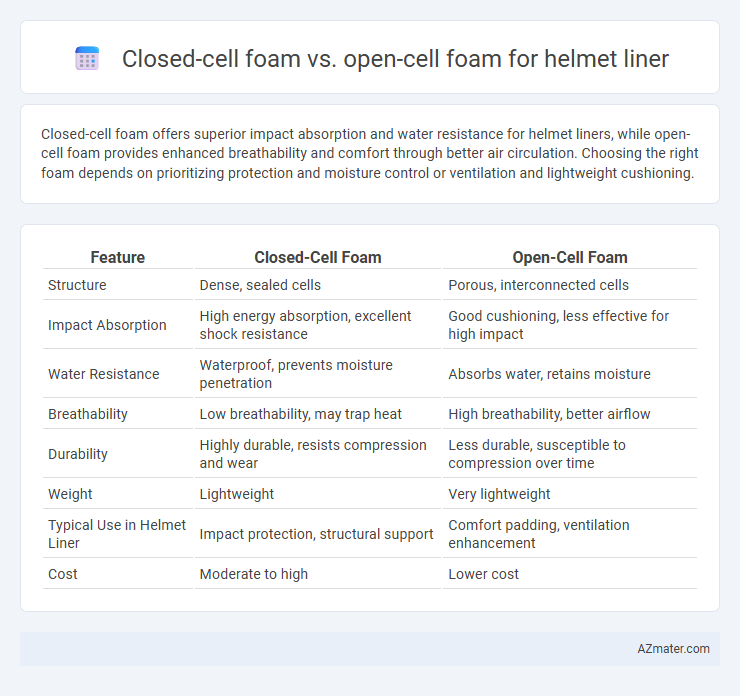Closed-cell foam offers superior impact absorption and water resistance for helmet liners, while open-cell foam provides enhanced breathability and comfort through better air circulation. Choosing the right foam depends on prioritizing protection and moisture control or ventilation and lightweight cushioning.
Table of Comparison
| Feature | Closed-Cell Foam | Open-Cell Foam |
|---|---|---|
| Structure | Dense, sealed cells | Porous, interconnected cells |
| Impact Absorption | High energy absorption, excellent shock resistance | Good cushioning, less effective for high impact |
| Water Resistance | Waterproof, prevents moisture penetration | Absorbs water, retains moisture |
| Breathability | Low breathability, may trap heat | High breathability, better airflow |
| Durability | Highly durable, resists compression and wear | Less durable, susceptible to compression over time |
| Weight | Lightweight | Very lightweight |
| Typical Use in Helmet Liner | Impact protection, structural support | Comfort padding, ventilation enhancement |
| Cost | Moderate to high | Lower cost |
Introduction to Helmet Liner Foams
Helmet liner foams are critical for impact absorption and comfort, with closed-cell foam providing superior water resistance and high-density cushioning ideal for enhanced protection. Open-cell foam offers greater breathability and flexibility, promoting ventilation and comfort but less effective in moisture resistance. Selecting the appropriate foam depends on balancing shock absorption, durability, and environmental conditions encountered during helmet use.
Understanding Closed-Cell Foam
Closed-cell foam used in helmet liners offers superior impact absorption and water resistance compared to open-cell foam, making it ideal for protective gear in wet or high-impact environments. Its dense structure prevents water absorption, enhancing durability and maintaining cushioning performance over time. This foam's rigidity provides consistent shock mitigation, critical for reducing head injuries during collisions.
What is Open-Cell Foam?
Open-cell foam is a lightweight, flexible material characterized by cells that are not completely enclosed, allowing air and moisture to pass through easily, which enhances breathability and comfort in helmet liners. This foam type offers excellent shock absorption and conformability, adapting well to head shapes for a snug fit, but it provides less water resistance and durability compared to closed-cell foam. Its porous structure makes it ideal for ventilation, reducing heat buildup during prolonged helmet use.
Key Material Differences
Closed-cell foam in helmet liners features a dense, waterproof structure with tightly packed cells that provide superior impact absorption and moisture resistance, making it ideal for high-performance protection. Open-cell foam consists of interconnected, porous cells that offer enhanced breathability and lighter weight but absorb moisture more readily, which can reduce long-term durability. The material choice between closed-cell and open-cell foam directly affects helmet comfort, safety, and maintenance requirements due to these fundamental structural characteristics.
Impact Absorption Capabilities
Closed-cell foam offers superior impact absorption capabilities for helmet liners due to its higher density and rigidity, effectively dispersing energy upon impact. Open-cell foam, being less dense and more flexible, provides better comfort but absorbs less force, making it less effective for high-impact protection. Choosing closed-cell foam enhances helmet safety by minimizing shock transmission to the head during collisions.
Weight and Comfort Comparison
Closed-cell foam for helmet liners offers superior lightweight properties due to its dense, sealed-cell structure, which enhances impact absorption without adding bulk. Open-cell foam, while slightly heavier, provides better breathability and flexibility, enhancing overall comfort by allowing air circulation and conforming more easily to head contours. The choice depends on prioritizing weight savings with durable cushioning (closed-cell) versus improved ventilation and softer fit (open-cell).
Durability and Lifespan
Closed-cell foam offers superior durability and a longer lifespan for helmet liners due to its dense, watertight structure that resists moisture, compression, and degradation over time. Open-cell foam, while providing better breathability and comfort, is more prone to wear, moisture absorption, and structural breakdown, which can significantly reduce its effective lifespan. Selecting closed-cell foam enhances helmet liner longevity in demanding environments where durability is critical.
Moisture and Breathability
Closed-cell foam helmet liners provide superior moisture resistance by preventing water absorption, ensuring the liner remains dry during intense activities. Open-cell foam offers enhanced breathability as its porous structure allows air circulation, promoting sweat evaporation and cooling. Selecting between the two depends on prioritizing either moisture barrier properties with closed-cell foam or ventilation benefits with open-cell foam for helmet comfort.
Cost Considerations
Closed-cell foam for helmet liners generally incurs higher costs due to its denser structure and superior impact absorption properties, which enhance safety but increase material expenses. Open-cell foam is more budget-friendly, offering lightweight comfort and breathability, yet it may require more frequent replacement because of lower durability. Choosing between these foams involves balancing initial investment against long-term maintenance and protective performance.
Choosing the Right Helmet Liner Foam
Closed-cell foam offers superior impact absorption and water resistance, making it the optimal choice for helmet liners in high-performance or water-prone environments. Open-cell foam provides enhanced breathability and comfort by allowing air circulation but may absorb moisture, which can reduce its protective qualities over time. Selecting helmet liner foam depends on balancing protection, durability, and comfort based on specific usage conditions and environmental factors.

Infographic: Closed-cell foam vs Open-cell foam for Helmet liner
 azmater.com
azmater.com